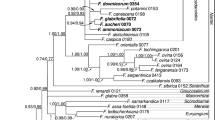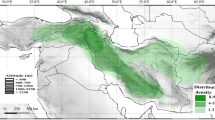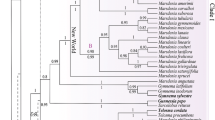Abstract
The little known Rubiaceae genus Villaria is endemic mostly to the coastal forests of the Philippines. Traditionally, it has been placed in the tribe Gardenieae. Later it was transferred to Octotropideae sensu Robbrecht and Puff. Villaria was placed among the “primitive” genera of the tribe, which are essentially characterized by large fruits, horizontal ovules and numerous seeds. Parsimony and Bayesian analyses of the combined plastid (rps16 and trnT-F) dataset strongly support the inclusion of Villaria in Octotropideae as well as monophyly of the genus. However, our molecular results do not conform to the current informal groups of the tribe delimited by fruit size, ovule position, number of seeds and exotesta thickenings. Instead, a close relationship between Villaria and two “central genera” (Hypobathrum and Pouchetia) is revealed for the first time. This clade is sister to a group comprising “primitive” (Fernelia), “advanced” (Kraussia and Polysphaeria) and “central” (Feretia) representatives. In addition, our combined tree strongly supports a sister taxa relationship between Canephora and Paragenipa. Villaria is characterized by unilocular ovaries, parietal placentation and strictly horizontal ovules. These features are unique within the Octotropideae. We recognize a total of five Villaria species, one new species (V. leytensis) is described here, and two species (V. philippinensis and V. rolfei) are transferred into synonymy with V. odorata. Each species is fully described, and a key to the species, a distribution map and illustrations are provided.





Similar content being viewed by others
References
Akaike H (1974) A new look at the statistical model identification. IEEE Trans Autom Control 19:716–723
Alejandro GD, Liede S (2003) The Philippine Rubiaceae genera: updated synopsis in INTKEY databases of the DELTA System. Blumea 48:261–277
Alejandro GD, Razafimandimbison S, Liede-Schumann S (2005) Polyphyly of Mussaenda inferred from ITS and trnT-F data and its implication for generic limits in Mussaendeae (Rubiaceae). Am J Bot 92:128–141
Alejandro GD, Meve U, Liede-Schumann S (2008) Two new species of Mussaenda (Rubiaceae) from Panay Island Philippines. Bot J Linn Soc 158:87–92
Alejandro GJD, Meve U, Uy M, Mouly A, Thiv M, Liede-Schumann S (2010) Molecular support of the classification of Greeniopsis Merr, in Aleisanthieae (Rubiaceae), with a revision of the genus. Taxon 59:1547–1564
Altekar G, Dwarkadas S, Huelsenbeck JP, Ronquist F (2004) Parallel metropolis coupled Markov chain Monte Carlo for Bayesian phylogenetic inference. Bioinformatics 20:407–415
Andersson L, Rova JHE (1999) The rps16 intron and the phylogeny of the Rubioideae (Rubiaceae). Pl Syst Evol 214:161–186
Andreasen K, Bremer B (1996) Phylogeny of the subfamily Ixoroideae (Rubiaceae). Opera Bot Belg 7:119–138
Andreasen K, Bremer B (2000) Combined phylogenetic analysis in the Rubiaceae–Ixoroideae: morphology nuclear and chloroplast DNA data. Am J Bot 87:1731–1748
Beille L (1939) Structure anatomique des Lemire. Revue Bot Appl Agric Trop 19:250–255
Blanco FM (1837) Serissa. Fl. Filip. [F.M. Blanco] 1:163–164
Bremekamp CEB (1966) Remarks on the position the delimitation and the subdivision of the Rubiaceae. Acta Bot Neerlandica 15:1–33
Bremer B (2009) A review of molecular phylogenetic studies of Rubiaceae. Ann Missouri Bot Gard 96:4–26
Bremer B, Eriksson T (2009) Time tree of Rubiaceae: phylogeny and dating the family subfamilies and tribes. Int J Plant Sci 170:766–793
Bremer B, Jansen JR, Oxelman B, Backlund M, Lantz H, Kim K-J (1999) More characters or more taxa for a robust phylogeny – case study from the coffee family (Rubiaceae). Syst Biol 48:413–435
Bremer B, Bremer K, Heidari N, Erixon P, Olmstead RG, Anderberg AA, Källersjö M, Barkhordarian E (2002) Phylogenetics of asterids based on 3 coding and 3 non-coding chloroplast DNA markers and the utility of non-coding DNA at higher taxonomic levels. Mol Phylogenet Evol 24:274–301
Bridson DM, Verdcourt B (2003) Rubiaceae. In: Pope GV (ed) Flora Zambesiaca 5(3):379–720. Kew, Royal Botanic Gardens
Chase MW, Hills HH (1991) Silica gel: an ideal material for preservation of leaf samples for DNA studies. Taxon 40:215–220
Davis AP, Chester M, Maurin O, Fay MF (2007) Searching for the relatives of Coffea (Rubiaceae, Ixoroideae): the circumscription and phylogeny of Coffeeae based on plastid sequence data and morphology. Am J Bot 94:313–329
De Block P (1998) The African species of Ixora (Rubiaceae–Pavetteae). Opera Bot Belg 9:1–218
Dessein S, Ochoterena H, De Block P, Lens F, Robbrecht E, Schols P, Smets E, Vinckier S, Huysmans S (2005) Palynological characters and their phylogenetic signal in Rubiaceae. Bot Rev 71:354–414
Dubard M, Dop P (1925) Étude de quelques types nouveaux ou peu connus de Rubiacées de Madagascar. J Bot (Morot) 3:1–31
Elmer ADE (1906) Gardenia acutifolia Elmer. Leafl Philipp Bot 1:6
Farris JS (1989) The retention index and the rescaled consistency index. Cladistics 5:417–419
Farris JS, Källersjö M, Kluge AG, Bult C (1994) Testing significance of incongruence. Cladistics 10:315–319
Fernandez-Villar C (1880) In: Novissima Appendix (ed. Naves A & Fernández-Villar C). In: Naves A (ed.) Blanco FM, Flora de Filipinas, ed. 3, 4 (ed. Naves A.): 1–375. Plana y Cia., Manila
Govaerts R, Ruhsam M, Andersson L, Robbrecht E, Bridson DM, Davis AP, Schanzer I, Sonké B (2006) World checklist of Rubiaceae. Royal Botanic Gardens, Kew. http://www.kew.org/wcsp/rubiaceae. Accessed 15 May 2011
Gustafsson C, Persson C (2002) Phylogenetic relationships among species of the neotropical genus Randia (Rubiaceae, Gardenieae) inferred from molecular and morphological data. Taxon 51:661–674
Holmgren PK, Holmgren NH, Barnett LC (1990) Index herbariorum. Part I The herbaria of the world. Regnum Veg 120:1–639
Huelsenbeck JP, Ronquist F (2001) MrBayes: Bayesian inference of phylogeny. Bioinformatics 17:754–755
Kiehn M (1985) Karyosystematische Untersuchungen an Rubiaceae: Chromosomenzählung aus Afrika, Madagaskar und Mauritius. Pl Syst Evol 149:89–118
Kiehn M (1996) Chromosomes of Rubiaceae occurring in Malesia, the Philippines, New Guinea, and the Pacific. Opera Bot Belg 7:249–260
Kluge AG, Farris JS (1969) Quantitative phyletics and the evolution of anurans. Syst Zool 18:1–32
Leroy JF (1976) Essais de taxonomie syncrétique sur une xérophyte remarquable du plateau Mahafaly (Madagascar): Jovetia humilis Guédès (Rubiacées-Ixorées). Adansonia II 16:5–12
Levin DA (1983) Polyploidy and novelty in flowering plants. Am Nat 122:1–25
Madulid DA (2001) A dictionary of Philippine plant names. Bookmark, Makati City
Merrill ED (1910) Villaria Rolfe. Philipp J Sci 5:248
Merrill ED (1918) Species Blancoanae: a critical revision of the Philippine species of plants described by Blanco and by Llanos. Bur Sci Publ 12:1–423
Merrill ED (1923) An enumeration of Philippine flowering plants, vol 2. Bureau of Printing, Manila, pp 532–533
Mouly A, Razafimandimbison SG, Florence J, Jérémie J, Bremer B (2009) Paraphyly of Ixora and new tribal delimitation of Ixoreae (Rubiaceae): inference from combined chloroplast (rps16, rbcL and trnT-F) sequence data. Ann Missouri Bot Gard 96:146–160
Mulyaningsih T, Ridsdale CE (2004) An additional species of Villaria Rolfe (Rubiaceae) from the Philippines. Reinwardtia 12:195–197
Naves A (ed) (1882) In: FM Blanco, Flora de Filipinas, ed. 3 (“Gran edicion”), Atlas I, Plana y Cia., Manila
Nicolson DH, Arculus D (2001) Candidates for neotypification of Blanco’s names of Philippine plants: specimens in the US National Herbarium. Taxon 50:947–954
Nylander JAA (2004) MrModeltest 20 Program distributed by the author. Evolutionary Biology Centre Uppsala University
Owens SJ, Jackson A, Maunder M, Rudall P, Johnson MAT (1993) The breeding system of Ramosmania heterophylla – dioecy or heterostyly? Bot J Linn Soc 113:77–86
Oxelman B, Lidén M, Berglund D (1997) Chloroplast rps16 intron phylogeny of the tribe Sileneae (Caryophyllaceae). Pl Syst Evol 206:393–410
Persson C (2000) Phylogeny of Gardenieae (Rubiaceae) based on chloroplast DNA sequences from the rps16 intron and trnL(UAA)-F(GAA) intergenic spacer. Nordic J Bot 20:257–270
Philip O, Mathew PM (1988) Cytology of the South Indian Rubiaceae and its bearing on the evolution and systematics of the family. In: PKK Nair (ed) Glimpses in plant research, vol 8, Today & Tomorrow, Delhi, pp 177–244
Puff C, Robbrecht E, Buchner R, De Block P (1996) A survey of secondary pollen presentation in the Rubiaceae. Opera Bot 7:369–402
Rambaut A (1996) Se-Al v1.0a1. http://tree.bio.ed.ac.uk/software/seal/. Accessed 15 May 2011
Razafimandimbison S, Bremer B (2002) Phylogeny and classification of Naucleeae s.l. (Rubiaceae) inferred from molecular (ITS, rbcL and trnT-F) and morphological data. Am J Bot 89:1027–1041
Robbrecht E (1980) The Hypobathreae (Rubiaceae-Ixoroideae) 1 delimitation and division of a new tribe. Bull Jard Bot Natl Belg 50:69–77
Robbrecht E (1988) Tropical woody Rubiaceae. Opera Bot Belg 1:1–271
Robbrecht E, Manen JF (2006) The major evolutionary lineages of the coffee family (Rubiaceae angiosperms): combined analysis (nDNA and cpDNA) to infer the position of Coptosapelta and Luculia and supertree construction based on rbcL, rps16, trnL-trnF and atpB-rbcL data: a new classification in two subfamilies Cinchonoideae and Rubioideae. Syst Geog Pl 76:85–146
Robbrecht E, Puff C (1986) A survey of the Gardenieae and related tribes (Rubiaceae). Bot Jahrb Syst 108:63–137
Robbrecht E, De Block P, Van Hecke P (1991) Incomplete rheophytic speciation in Pouchetia (African Rubiaceae–Hypobathreae). Belg J Bot 124:137–151
Robbrecht E, Bridson DM, Debb D (1993) The South Indian genus Octotropis (Rubiaceae). An investigation of its characters and reinstatement of the tribal name Octotropideae. Opera Bot Belg 6:81–91
Rolfe RA (1884) Rubiaceae. J Linn Soc Bot 21:311–312
Ronquist F, Huelsenbeck JP (2003) MrBayes 3: Bayesian phylogenetic inference under mixed models. Bioinformatics 19:1572–1574
Rova JHE, Delprete P, Andersson L, Albert V (2002) A trnL-F cpDNA sequence study of the Condamineeae–Rondeletieae–Sipaneeae complex with implications on the phylogeny of the Rubiaceae. Am J Bot 89:145–159
Ruhsam M, Davis AP (2007) A taxonomic revision of the genus Flagenium Baill (Rubiaceae–Octotropideae). Bot J Linn Soc 155:557–570
Sarkar AK, Datta R, Chatterjee U, Hazra D (1982) In: Löve A (ed) IOPB chromosome number reports LXXVI. Taxon 31:576–579
Schumann K (1891) Rubiaceae. In: Engler A, Prantl K (eds) Die natürlichen Pflanzenfamilien. Ergänzungsheft, vol 4. Engelmann, Leipzig, pp 1–156
Schwartz G (1978) Estimating the dimensions of a model. Ann Stat 6:461–464
Snow R (1963) Alcoholic hydrochloric acid-carmine as stain for chromosomes in squash preparations. Stain Technol 38:9–13
Stone JR, Davis AP (2004) New taxa and nomenclatural notes on the flora of the Marojejy Massif, Madagascar. VI. Rubiaceae: a new species of Lemyrea. Novon 14:119–123
Swofford DL (2000) PAUP*: Phylogenetic Analysis Using Parsimony (*and Other Methods) version 40b. Sinauer Associates, Sunderland, MA
Taberlet PL, Gielly L, Patou G, Bouvet J (1991) Universal primers for amplification of three non-coding regions of chloroplast DNA. Pl Mol Biol 17:1105–1109
Tirvengadum DD (1982) Ramosmania, a new monotypic genus of Mascarene Rubiaceae. Nord J Bot 2:323–327
Tirvengadum DD, Robbrecht E (1985) Remarks on three Hypobathreae (Rubiaceae) from Rodrigues, Seychelles and Sri Lanka. Nord J Bot 5:455–461
Tirvengadum DD, Verdcourt B (1989) Ramosmania. In: Bosser J, Cadet T, Guého J, Marais W (eds) Flore des Mascareignes: La Réunion, Maurice, Rodrigues, 107, Caprifoliacées à 108 Valérianacées. Kew: Royal Botanic Gardens; Mauritius: The Sugar Industry Research Institute; Paris: L’Office de la Recherche Scientifique et Technique Outre-Mer, pp 78–80
Tjio JH, Levan A (1950) The use of oxychinoline in chromosome analysis. Anales Estac Exp Aula Dei 2:21–64
Tosh J, De Block P, Davis AP, Dessein E, Robbrecht E, Smets EF (2008) The tribal placement of the monospecific tropical African genus Petitiocodon (Rubiaceae) based on molecular data and morphology. Blumea 53:549–565
Verdcourt B (1958) Remarks on the classification of the Rubiaceae. Bull Jard Bot État 28:209–281
Verdcourt B (1988) Polysphaeria. In: Polhill RM (ed) Flora of Tropical East Africa: Rubiaceae, part 2. Balkema, Rotterdam, pp 569–579
Verdcourt B (1989) Fernelia. In: Bosser J, Cadet T, Guého J, Marais W (eds) Flore des Mascareignes: La Réunion, Maurice, Rodrigues 107, Caprifoliacées à 108 Valérianacées. Kew: Royal Botanic Gardens; Mauritius: The Sugar Industry Research Institute; Paris: L’Office de la Recherche Scientifique et Technique Outre-Mer, pp 80–84
Vidal S (1885) Villaria littoralis and Villaria rolfei. Phan Cuming Philipp 180
Yang Z (1994) Maximum likelihood phylogenetic estimation from DNA sequences with variable rates over sites: approximate methods. J Mol Evol 39:306–314
Acknowledgments
We thank the following herbaria and their staff for providing loans and/or access to collections: A, CAHUP, G, GH, K, L, NY, P, PNH, PR, US and USTH. We are also grateful to three anonymous reviewers for helpful comments and suggestions. The first author thanks Angelika Täuber for guidance during the molecular work, Irma Mika for Latin translations, Nemecio Diego for some parts of the illustrations, the University of Santo Tomas, Manila, Philippines, for some financial support during the field collection; and the Alexander von Humboldt Foundation for a Postdoctoral Fellowship grant.
Author information
Authors and Affiliations
Corresponding author
Additional information
G.J.D. Alejandro dedicates this work to the late Eduardo P. de Leon, a good friend who made several collections of Villaria.
Rights and permissions
About this article
Cite this article
Alejandro, G.J.D., Meve, U., Mouly, A. et al. Molecular phylogeny and taxonomic revision of the Philippine endemic Villaria Rolfe (Rubiaceae). Plant Syst Evol 296, 1–20 (2011). https://doi.org/10.1007/s00606-011-0472-9
Received:
Accepted:
Published:
Issue Date:
DOI: https://doi.org/10.1007/s00606-011-0472-9




